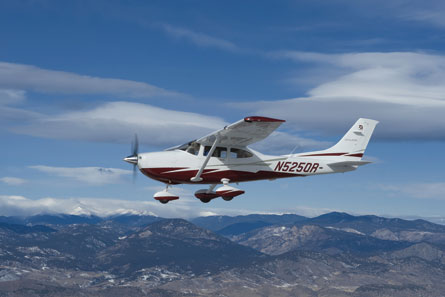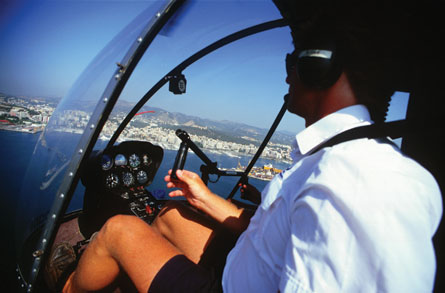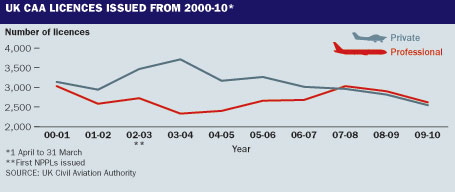Private flying was once considered a highly desirable pastime. For decades, experienced and trainee pilots were in abundance at clubs and flying schools across Europe, and light aircraft dotted around the airspace was a familiar sight. But now the numbers are dwindling fast, with many training schools and clubs struggling to attract new flyers.
The UK is one of the worst-hit countries in Europe. The total of new private and commercial pilots licences issued by the Civil Aviation Authority has been falling since 2003, although the decline has been particularly rapid over the past four years. "The financial downturn has hit this industry hard," says Martin Robinson, chief executive of the Aircraft Owners and Pilots Association (AOPA) UK and regional vice-president of IAOPA Europe.
The costs of flying is only a small factor in the decline of Europe's flying training industry, says Robinson. He estimates that since 2007 the number of pilot training recruits has fallen by 30% in the UK, as people spend money on other leisure pursuits or pressing commitments. It typically costs about £8,000 ($12,900) to obtain a private pilot's licence and about £65,000 for a commercial licence. In 2002 the UK introduced a localised, less rigorous and cheaper version of the PPL, which helped to attract new entrants, but the tally has declined year on year since 2003.
 |
|---|
©Credit StyleCessna says it recently sold its 182 Skylane to a German flight school |
"The cost of training is expensive in itself; factor in the escalating cost of fuel and you can see why people have to think twice before taking up flying or even continuing to fly for pleasure," says Robinson.
This view is supported by Jonny Greenall, managing director of Sloane Helicopters Mallorca. "We don't have problems with weather here, but it is becoming more difficult to attract new flyers to this small niche market," he admits. "It costs around £15,000 to get a PPL on a Robinson two-seat R22 single-engined helicopter, and around £60,000 for a commercial pilot's licence. It takes very deep pockets and a great deal of dedication and determination."
Robinson says "it is not a young person's activity any longer. More licences are issued to 40- to 60-year-olds than to any other age group, as they typically have more disposable income."
Even in this age group, enthusiasm can wane as flying becomes more costly and burdensome, he adds. "The industry must compete head-on with other leisure pursuits if private flying is to stand a chance of attracting newcomers and retaining existing licence holders."
An equally challenging and pressing battle for the GA community is tackling hostility at a local, national level. "The image of light aircraft as noisy and intrusive can dissuade people from taking up flying," says Robinson, who notes also that "it is not politically correct to take part in an activity that is seen as environmentally unfriendly".
David Ogilvy, former president of the General Aviation Awareness Council, argues that flying sites are continually under threat, be it from international airports that have largely driven out GA traffic due to the low financial return; regional airports that increase landing fees such that it is no longer viable for small aircraft to operate there; or from environmental initiatives such as wind farms and eco towns.
"It is vital to keep flying sites open," he says. "If these facilities are removed from the locality, many people who might wish to fly will take up other pastimes and will be lost as prospective newcomers to the flying profession."
Flying clubs and training companies are seeking to lure new entrants to the fold. "It isn't an easy task," admits Luke Hall, chief instructor and sales manager of Marshall Aerospace-owned Cambridge Aero Club. "The key is to offer a service that is exciting and enticing."
Hall says the individuals wanting to learn to fly in the current economic climate have discretionary income and are looking for quality training. "Those companies that offer training at knockdown prices will not survive," he says. "People want a niche, elite product."
This view is shared by Pana Poulios, Cessna's European sales director for propeller aircraft. "You have to market yourselves differently today to draw in the customers. I recently sold [Cessna] 182 Skylanes to a German flight school. The owner wanted these high-end piston singles because they offer more comfort than other typical training/leisure aircraft and that was type of customer he wanted to attract. The gamble has paid off."
Poulis admits that sales of propeller-driven aircraft are down, but says he is working on project to supply 14 Cessna 172 Skyhawks to the St Petersburg State Aviation Academy in Russia. "Schools have to invest in the latest technology to attract new customers. Trainee pilots will typically own the latest top-of-the-range electronic gadgets so they don't expect to fly on 25-year-old aircraft with steam gauges."
 |
|---|
©Sloane HelicoptersGaining a private pilot's licence in a single-engined R22 can cost around £15,000 |
Expensive Investments
The 172 and 182 might be considered expensive investments for many training schools, but the Model 162 SkyCatcher light sport aircraft could help invigorate the market by driving down the costs of training and aircraft ownership. "The $112,500 SkyCatcher is almost $200,000 cheaper than the Skyhawk, but has all the modern aircraft features," he says. To date, around a third of the 1,000-strong SkyCatcher orderbook is destined for European customers, although Poulis is uncertain when the first delivery will be.
Robinson agrees that SkyCatcher and other LSAs could help to lower the cost of training, but he says the industry must boost the appeal of training and private flying. "Flying does not have the same cachet it used to have," he says, pointing to a study commissioned by its sister association in the USA which examined why pilots drop out of training.
The report says: "The training industry does not make enough of the exclusivity and sense of achievement people get from becoming a pilot. The 'cool factor' is an under-exploited asset for flight training organisations, which could make more of the fact that learning to fly sets you apart from common folk."
For Robinson, re-igniting the romance of flying and promoting a sense of freedom are essential if the industry wants to appeal to newcomers and encourage licence-holders to continue flying. He fears, however, that burdensome regulation surrounding the harmonisation of flightcrew licencing in Europe from April 2012 is going to provide yet another "layer of costly, unnecessary bureaucracy" for pilots.
"Take the UK for example," he says. "Because EASA [the European Aviation Safety Agency] does not recognise national licences issued by the Civil Aviation Authority, pilots will have to surrender their national licences - which are valid for life - and pay for JAA licences - which are valid for five years. The conversion costs around €200. When these licences expire, they will have to covert them into EASA licences, which are once again valid for life."
Collectively, this will cost the GA community millions, says Robinson, who considers it unjust that pilots have to pay the conversion fees at a time when activity is suppressed by the downturn. "No cost should fall on pilots who are forced to conform to old regulations written on new pieces of paper," he asserts.
Similar dissent is still rife across the flying training community after EASA's introduction, two years ago, of the controversial "continuing airworthiness management organisations", which were brought in to provide annual airworthiness reviews for clients, says Sloane's Greenall. "They are supposed to increase safety, but have just added another tier of bureaucracy and increased costs, which have to be absorbed by training schools or passed on to customers."
Flightcrew licensing harmonisation has meanwhile sounded the death knell for the UK's highly prized instrument meteorological condition rating despite strong opposition from AOPA and the UK CAA.
Around 26,000 people have achieved their IMC rating since it was introduced in 1967 to teach low-time pilots to cope with instrument meteorological conditions and get their aircraft safely back on the ground.
Although EASA has conceded "grandfather rights" to current holders, the industry is campaigning for new pilots to be allowed the rating in the UK. "The case for the IMCR is a no-brainer," Robinson says. "It is one of the major reasons why Britain's GA safety rate is so much better than most of the rest of Europe"
It is difficult to be precise about how much safer Britain is, because countries record statistics differently and do not all have comparable GA industries, but a simple tally of fatalities tells a story. AOPA looked at the figures around three years ago, and found that in France there were an average of 90 fatalities a year in all forms of GA; in Germany there were about 80; and in Britain the average was 20 to 25.
"The threat to the IMCR is an unintended consequence of European harmonisation, and a means can and must be found to save it," says Robinson.
 |
|---|
Source: Flight International























